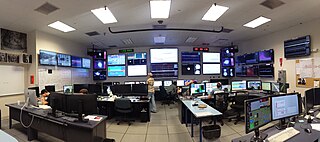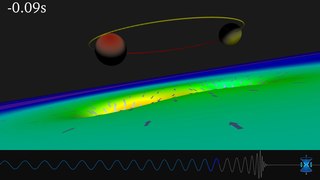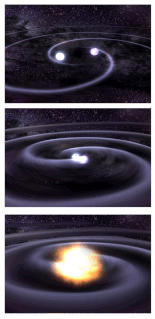
The Laser Interferometer Gravitational-Wave Observatory (LIGO) is a large-scale physics experiment and observatory designed to detect cosmic gravitational waves and to develop gravitational-wave observations as an astronomical tool. Two large observatories were built in the United States with the aim of detecting gravitational waves by laser interferometry. These observatories use mirrors spaced four kilometers apart which are capable of detecting a change of less than one ten-thousandth the charge diameter of a proton.

Rainer "Rai" Weiss is an American physicist, known for his contributions in gravitational physics and astrophysics. He is a professor of physics emeritus at MIT and an adjunct professor at LSU. He is best known for inventing the laser interferometric technique which is the basic operation of LIGO. He was Chair of the COBE Science Working Group.

The Laser Interferometer Space Antenna (LISA) is a proposed space probe to detect and accurately measure gravitational waves—tiny ripples in the fabric of spacetime—from astronomical sources. LISA would be the first dedicated space-based gravitational wave detector. It aims to measure gravitational waves directly by using laser interferometry. The LISA concept has a constellation of three spacecraft arranged in an equilateral triangle with sides 2.5 million kilometres long, flying along an Earth-like heliocentric orbit. The distance between the satellites is precisely monitored to detect a passing gravitational wave.

The Michelson interferometer is a common configuration for optical interferometry and was invented by the 19/20th-century American physicist Albert Abraham Michelson. Using a beam splitter, a light source is split into two arms. Each of those light beams is reflected back toward the beamsplitter which then combines their amplitudes using the superposition principle. The resulting interference pattern that is not directed back toward the source is typically directed to some type of photoelectric detector or camera. For different applications of the interferometer, the two light paths can be with different lengths or incorporate optical elements or even materials under test.

GEO600 is a gravitational wave detector located near Sarstedt, a town 20 km to the south of Hanover, Germany. It is designed and operated by scientists from the Max Planck Institute for Gravitational Physics, Max Planck Institute of Quantum Optics and the Leibniz Universität Hannover, along with University of Glasgow, University of Birmingham and Cardiff University in the United Kingdom, and is funded by the Max Planck Society and the Science and Technology Facilities Council (STFC). GEO600 is capable of detecting gravitational waves in the frequency range 50 Hz to 1.5 kHz, and is part of a worldwide network of gravitational wave detectors. This instrument, and its sister interferometric detectors, when operational, are some of the most sensitive gravitational wave detectors ever designed. They are designed to detect relative changes in distance of the order of 10−21, about the size of a single atom compared to the distance from the Sun to the Earth. Construction on the project began in 1995.

The Kamioka Gravitational Wave Detector (KAGRA), formerly the Large Scale Cryogenic Gravitational Wave Telescope (LCGT), is a project of the gravitational wave studies group at the Institute for Cosmic Ray Research (ICRR) of the University of Tokyo. It became operational on 25 February 2020, when it began data collection. It is Asia's first gravitational wave observatory, the first in the world built underground, and the first whose detector uses cryogenic mirrors. The design calls for an operational sensitivity equal to, or greater than, LIGO and Virgo. KAGRA is located in the Kamioka Observatory in Gifu Prefecture, Japan. The observatory specializes in the detection of neutrino, dark matter and gravitational waves, and possesses other important instruments, including Super Kamiokande, XMASS and NEWAGE.
Hyper-Kamiokande is a neutrino observatory being constructed on the site of the Kamioka Observatory, near Kamioka, Japan.
The Kamioka Observatory, Institute for Cosmic Ray Research is a neutrino and gravitational waves laboratory located underground in the Mozumi mine of the Kamioka Mining and Smelting Co. near the Kamioka section of the city of Hida in Gifu Prefecture, Japan. A set of groundbreaking neutrino experiments have taken place at the observatory over the past two decades. All of the experiments have been very large and have contributed substantially to the advancement of particle physics, in particular to the study of neutrino astronomy and neutrino oscillation.

The Virgo interferometer is a large interferometer designed to detect gravitational waves predicted by the general theory of relativity. Virgo is a Michelson interferometer that is isolated from external disturbances: its mirrors and instrumentation are suspended and its laser beam operates in a vacuum. The instrument's two arms are three kilometres long and located in Santo Stefano a Macerata, near the city of Pisa, Italy.

Gravitational waves are disturbances or ripples in the curvature of spacetime, generated by accelerated masses, that propagate as waves outward from their source at the speed of light. They were first proposed by Oliver Heaviside in 1893 and then later by Henri Poincaré in 1905 and subsequently predicted in 1916 by Albert Einstein on the basis of his general theory of relativity. Later he refused to accept gravitational waves. Gravitational waves transport energy as gravitational radiation, a form of radiant energy similar to electromagnetic radiation. Newton's law of universal gravitation, part of classical mechanics, does not provide for their existence, since that law is predicated on the assumption that physical interactions propagate instantaneously – showing one of the ways the methods of classical physics are unable to explain phenomena associated with relativity.

A gravitational-wave detector is any device designed to measure tiny distortions of spacetime called gravitational waves. Since the 1960s, various kinds of gravitational-wave detectors have been built and constantly improved. The present-day generation of laser interferometers has reached the necessary sensitivity to detect gravitational waves from astronomical sources, thus forming the primary tool of gravitational-wave astronomy.

Gravitational-wave astronomy is an emerging branch of observational astronomy which aims to use gravitational waves to collect observational data about objects such as neutron stars and black holes, events such as supernovae, and processes including those of the early universe shortly after the Big Bang.

TAMA 300 is a gravitational wave detector located at the Mitaka campus of the National Astronomical Observatory of Japan. It is a project of the gravitational wave studies group at the Institute for Cosmic Ray Research (ICRR) of the University of Tokyo. The ICRR was established in 1976 for cosmic ray studies, and is currently developing the Kamioka Gravitational Wave Detector (KAGRA).
Einstein Telescope (ET) or Einstein Observatory, is a proposed third-generation ground-based gravitational wave detector, currently under study by some institutions in the European Union. It will be able to test Einstein's general theory of relativity in strong field conditions and realize precision gravitational wave astronomy.

The European Underground Rare Event Calorimeter Array (EURECA) is a planned dark matter search experiment using cryogenic detectors and an absorber mass of up to 1 tonne. The project will be built in the Modane Underground Laboratory and will bring together researchers working on the CRESST and EDELWEISS experiments.
The DECi-hertz Interferometer Gravitational wave Observatory is a proposed Japanese, space-based, gravitational wave observatory. The laser interferometric gravitational wave detector is so named because it is to be most sensitive in the frequency band between 0.1 and 10 Hz, filling in the gap between the sensitive bands of LIGO and LISA. If funding can be found, its designers hope to launch it in 2027.
Multi-messenger astronomy is astronomy based on the coordinated observation and interpretation of disparate "messenger" signals. Interplanetary probes can visit objects within the Solar System, but beyond that, information must rely on "extrasolar messengers". The four extrasolar messengers are electromagnetic radiation, gravitational waves, neutrinos, and cosmic rays. They are created by different astrophysical processes, and thus reveal different information about their sources.
The Cryogenic Low-Energy Astrophysics with Noble liquids (CLEAN) experiment by the DEAP/CLEAN collaboration is searching for dark matter using noble gases at the SNOLAB underground facility. CLEAN has studied neon and argon in the MicroCLEAN prototype, and running the MiniCLEAN detector to test a multi-ton design.
Marica Branchesi is an Italian astrophysicist. Her leadership and scientific work was pivotal for Virgo/LIGO's discovery of gravitational waves. She is vice president of International Astronomical Union Gravitational Wave Astrophysics Commission and member of the Gravitational Wave International Committee.

The International Axion Observatory (IAXO) is a next-generation axion helioscope for the search of solar axions and axion-like particles. It is the follow-up of the CERN Axion Solar Telescope (CAST), which has been operating since 2003. The IAXO will be set up by implementing the helioscope concept used in the CAST experiment to its largest possible size.













